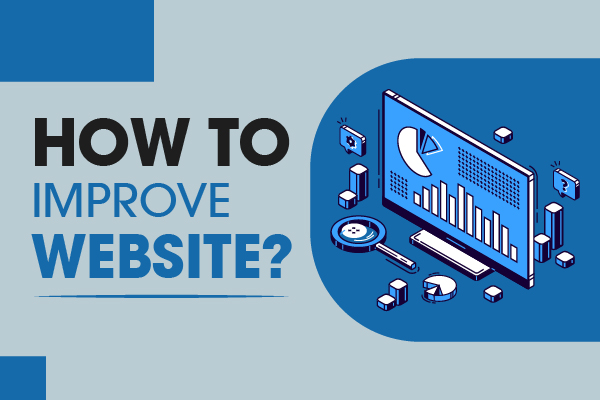9 Tips to Improve Your Website
Improving your website will give you an edge over your competitors, help you gain more followers, and retain your current followers.
Being able to share good information with users should just be one of your goals. Apart from working on your SEO for gaining organic traffic, improving your website's functionality should also be a top priority.
We are certain that you have visited those websites that are not user-friendly – they are just so difficult to navigate. So you end up leaving the website and moving on to another one. It's frustrating when that happens.

You can prevent this from happening to your site with some tips we’ll share below. Let’s run down 9 actionable tips to help you improve your website:
Tips to Improve Website
- Improve Page Load Times
- Keep to a Schedule
- Be Consistent Across the Site
- Always Use Heading and Subheadings
- Use Simple and Familiar Navigation Layouts for Your Pages
- Add a Best Articles or Best Products Section to Your Homepage
- Use Images and Infographics
- Put a Search Box to your Website
- Do Website Testing
Let's have a look at them in detail.
1. Improve Page Load Times
Slow web pages are extremely frustrating for visitors to read and for webmasters to work on. It shouldn't take more than 2 seconds for a page to load up – when it takes more than that, chances are, the user may totally leave your site and move on to a site with a better page load speed. This will, in turn, increase your bounce rate, and negatively impact SEO. You can't afford this when you're running a business online.
To better understand where your website needs improvement you can use a tool like Google’s PageSpeed Insights to run a test on one of your pages and get a detailed breakdown about what changes you should make.
Ideally, you want to reach the point where all stats are in the green, and your total score remains between 90-100.
2. Keep to a Schedule
Calendars are extremely useful as the users can practically check what's going on with your website. You must keep track and adhere to a schedule and help people build habits to visit your site regularly for new content. Integrating something like a calendar allows the audience to know what your plans are – whether you are launching a new product or hosting an event.
It's extremely easy to add this to your website. WordPress users only need to visit the Plugins section of your Dashboard and click Add New. You may type the Simple Calendar in the search bar and just click Install Now. Then Activate it right after.
This HostingWiki article should tell you everything that you need about adding a Google Calendar to your website.
3. Be Consistent Across the Site
It would help if you use the same layout for your webpages. This is to help the user familiarize with your site. It will be a lot easier for them to navigate the site if it has the same themes. Additionally, it will cut down costs on site maintenance, as you’ll only need to worry about improving a single layout.
Make it a goal to have the same websafe font and colors for all your webpages. This also reassures the user that they have not been redirected to other web pages.
If you are running a business, it would help if you can use your brand's color and font too.
4. Always Use Heading and Subheadings
Make use of headings and subheadings especially when you are publishing long-form content. This helps break up the content and actually looks better to the user.
It's also better to look for certain information when it has headings and subheadings. SEO wise, this is also a good idea. Effective use of headings will make your articles easier to skim, which in turn will make them more attractive to the reader.
5. Use Simple and Familiar Navigation Layouts for Your Pages
As much as possible, make it simple. A complex website will only frustrate the user. Your goal should be to help the user easily navigate your website so they won't be confused.
Try to visit websites that you like and see which ones you are comfortable using. The user always prefer a simple yet elegant layout. It should not be difficult for them to get the information that they want. Go with the tried and tested layout to avoid user problems in the future.
6. Add a Best Articles or Best Products Section to Your Homepage
Add a Best Articles section if you are publishing how-to content, reviews, or whatever else. Showing them the most read or the most useful articles helps both of you. It helps your users because it saves time. At the same time, it helps you too. If you are able to showcase the best articles, chances are your visitors will come back.
It's the same when you are selling products and services. You may want to show the users the products and services your customers prefer. It will help if you can also provide great reviews. You may be able to get sales conversions when you do this.
7. Use Images and Infographics
Visual content is important for the users too especially when your website is about interior design or photography. You will need more photos for this.
If you are providing useful content, infographics will be extremely useful. Just make sure that you upload only high-quality pictures and infographics.
Great images will attract more visitors to your site. Just don't overdo them. Also, make sure that your load time will not be affected.
8. Put a Search Box to your Website
Imagine how frustrating it is when you have loads of content published on your website and yet the user can't search for the info that they are looking for.
Add a search box in addition to adding categories. It will help if you can categorize content to help the user navigate your site well. Better yet, add a sitemap to your website. A sitemap will not be helpful to the user, it's also a must for SEO. It will tell Google about your most important site’s pages.
9. Do Website Testing
Website testing is a must for improving your website. This is used for checking potential bugs that could affect a user's experience. This also checks the usability, functionality, and security of the website.In addition, it will check whether your website is compatible with all devices and all browsers, it has any bug or not, It is secured with SSL certificate or not, etc.
Conclusion
To improve user experience it's imperative that you follow these 9 tips to improve website. If your goal is to strive in the industry and to gain an enormous following or have more sales, make Improving your website a top priority. Over time, it will create brand awareness and convert more sales.


